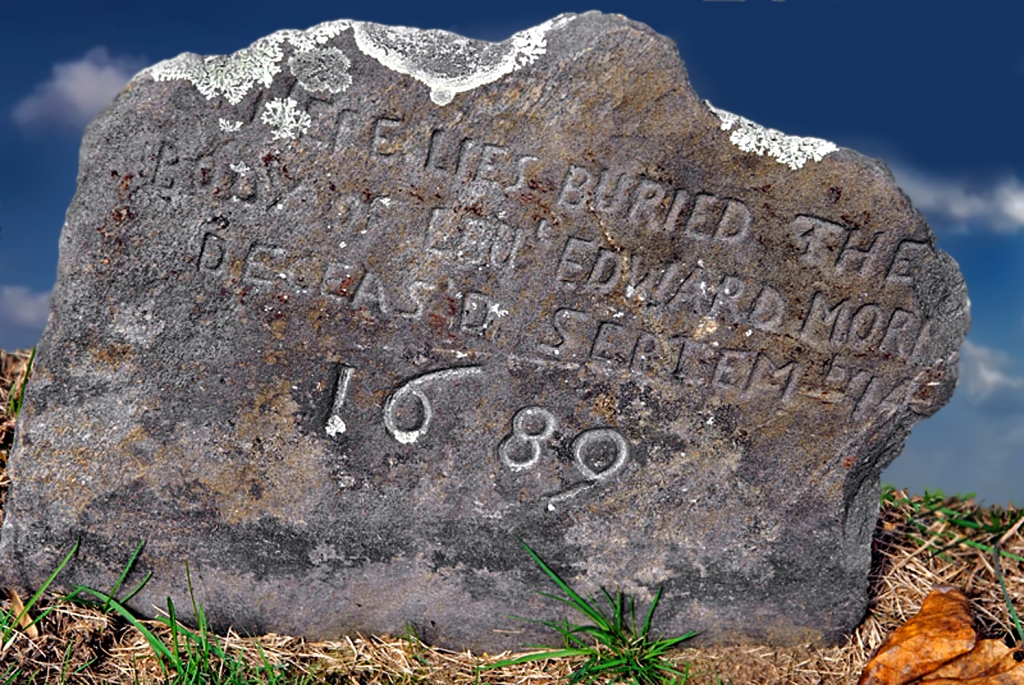Edward Morris 9th great grandpa on RootsMagic tree
Edward Morris was born on August 30, 1630 in Great Amwell, Hertfordshire, England. In 1651, he sailed on the ship Confidence to Roxbury, Massachusetts. On February 23, 1652 in Roxbury it was, “Voted that William Peacock and Edward Morris have four acres each William Lyon three acres upon the commons by John Polley.” There were conditions to receiving the land: William and Edward had to build within 2 years and could not “carry away any wood or timber or sell farther than for building purposes”.
September 20, 1655 Edward married Grace Bett. “Edward Morris & Grace Bett were married 20th – 9th month by Richard Bellingham Dept. Govr.” Grace and Edward had 12 children, all born in Roxbury.
January 27, 1661 Edward was a selectman and surveyor. In 1662 the townspeople decided no more land should be given away but kept for Roxbury community use. Edward was a constable in 1664, this included being a ‘fence viewer’, settling property disputes. He was a deputy to the General Court during the time when Massachusetts Bay Colony fought against England’s King Charles 2 for a charter. Edward Randolph, “evil genius of New England and her angel of death”, convinced Charles 2 to take away the charter and put Edmund Andros in charge, who was overthrown in the 1689 Boston Revolt. “We must believe that he [Edward] was in full sympathy with the sentiment of his townsmen and the party which stood in defense of popular liberty in the conflict against the arbitrary power of the King. and his instruments”.
Edward and family moved to Woodstock Connecticut around 1686 and were some of the first English settlers. Edward’s son Ebenezer was part of the exploring party. Edward died on September 14, 1689, sources say he was the first original settler to die in Woodstock. He is buried at Woodstock Hill Cemetery. There is a memorial to Edward and Grace Bett Morris and Edward’s original gravestone is still there.

Edward’s descendants moved west across America, his 5th great granddaughter Delia Angell born 1839, in Indiana moved further west to Butler County, Iowa where her great granddaughter Elizabeth Speedy was born in 1917.
Sources
- Marriage, Report of the Record Commissioners of the City of Boston at HathiTrust
- England births and christenings 1538-1975 at FamilySearch.org
- Topographical dictionary of 2885 English emigrants at HathiTrust
- A Genealogical and historical register of the descendants of Edward Morris at Archive.org
- Map in The history of Woodstock, Connecticut at HathiTrust
- Find a grave memorial, photo “Added by: Dave Guerra on 22 Mar 2015”.
- Edward Randolph and Edmund Andros at Wikipedia



 By 1642 George had left Ipswich, England and was in Massachusetts. He was a freeman on May 10 1643 in Boston. George’s first wife Phebe could have arrived with him or could have died in England, it’s unknown. George remarried in Massachusetts and he and 2nd wife had a few more children. His 2nd wife was Elizabeth the widow of John Simson. Both George and John were original English land owners in Watertown. On the map of Watertown, they’re neighbors, No. 12 right in between Strawberry Hill and the Meeting House. George has land at the top right too, No 16 above Sherman’s Pond
By 1642 George had left Ipswich, England and was in Massachusetts. He was a freeman on May 10 1643 in Boston. George’s first wife Phebe could have arrived with him or could have died in England, it’s unknown. George remarried in Massachusetts and he and 2nd wife had a few more children. His 2nd wife was Elizabeth the widow of John Simson. Both George and John were original English land owners in Watertown. On the map of Watertown, they’re neighbors, No. 12 right in between Strawberry Hill and the Meeting House. George has land at the top right too, No 16 above Sherman’s Pond
 On 6 April 1637 the church of Concord ‘kept a day of humiliation, chose Mr Bulkeley teacher and Mr. Jones pastor’. In August 1637 John and other minsters held an Ecclesiastical Council- they worked on their new religion: beliefs, requirements, practices in the new world. In 1644 another council was held and this time Peter Bulkeley and John Jones split- they couldn’t agree so John Jones and family left Concord and went to Fairfield Connecticut where John was the 1st pastor of the Congregational Church of Fairfield. John and Peter’s kids were married by this time, Peter’s son Thomas, married to Sarah Jones, Thomas and Sarah Jones Bulkeley went with John, to Fairfield.
On 6 April 1637 the church of Concord ‘kept a day of humiliation, chose Mr Bulkeley teacher and Mr. Jones pastor’. In August 1637 John and other minsters held an Ecclesiastical Council- they worked on their new religion: beliefs, requirements, practices in the new world. In 1644 another council was held and this time Peter Bulkeley and John Jones split- they couldn’t agree so John Jones and family left Concord and went to Fairfield Connecticut where John was the 1st pastor of the Congregational Church of Fairfield. John and Peter’s kids were married by this time, Peter’s son Thomas, married to Sarah Jones, Thomas and Sarah Jones Bulkeley went with John, to Fairfield.
You must be logged in to post a comment.